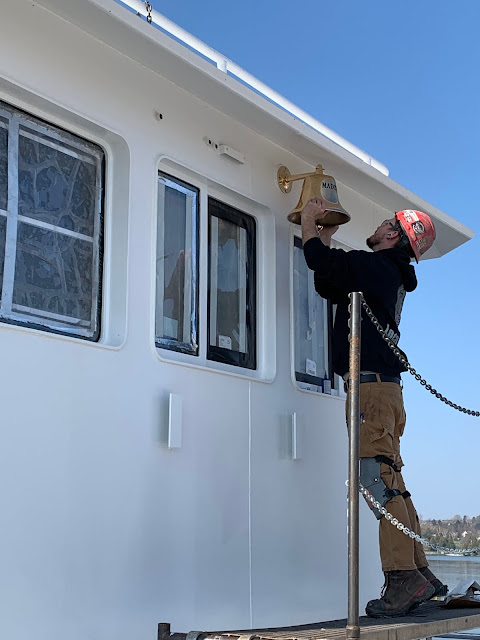
Detroit Harbor, Washington Island -
After nearly 48 hours of rain and strong NE winds, we now have sunshine, warmer air (and still strong NE winds.) The day has shaped up, however, and as we approach the Memorial Day weekend, the first holiday weekend since this Covid-19 business began, and since people have stayed in or very close to home, and businesses have remained, for the most part, closed, we do anticipate seeing more traffic coming to Washington Island.
Ferry trip frequency may be fluid during the Memorial Day holiday weekend. In mid-to-late June other adjustments may be made, in accordance with general traffic patterns.
The four-trip per day schedule, which has been sufficient, for the most part, is about to be expanded. This change will begin Thursday, May 21, with six scheduled round trips--which was actually the ferry schedule that we had intended to run through April into early May, before bumping up to 11 round trips daily.
We're increasing trips, according to Hoyt Purinton, but not getting carried away.
Ferry schedule effective Thursday, May 21, 2020
Lv. Island Lv. Northport
7:00 am 8:00 am
8:45 am 9:30 am
10:15 am 11:00 am
NOON 1:00 pm
2:00 pm 3:00 pm
4:00 pm 5:00 pm
FRIDAY NITE TRIP SCHEDULE (begins May 22, 2020)
7:00 pm 7:45 pm
Its advisable to look at the drop-down box on the website wisferry.com in order to get the latest schedule information.
Anticipating there will be more folks showing up at Northport, and not knowing just what that traffic volume might look like, a second boat and crew will be ready to follow up. If need be, a third ferry will be available Saturday through Monday to jump in when necessary. All crew and shore staff will wear masks, gloves, and will try to reduce interaction with members of the public to the extent possible. We would appreciate it if the public takes the same measure of safety: keep a generous distance whenever possible; be considerate and wear a mask in close proximity to others; stay in your vehicle for the ride across, if you boarded in an auto; and be patient! These are like baby steps, ones that are a long time in coming, still a bit unsteady on our feet.
What about the Karfi to Rock Island?
Aside from high water and potentially dangerous landing situations ( the dock surface potentially being swept by waves), which is daunting enough, we are uncertain at this point to what extent the State Park will be up and running. If, for instance, the buildings are not open, that might be a disappointment to the general public, especially those who count on going up in the lighthouse, or looking around in the Thordarson Boathouse. But, we should remember how difficult it will be to keep surfaces sanitized, and by placing the public feet, or even inches, away from docents and Park employees, a potentially hazardous situation may ensue regarding transfer of the coronavirus. The same can be said for the small, close-quartered Karfi, where passengers mingle, and camping gear and picnic baskets mingle, and our vapors can also mingle. How can we do this and maintain best social distancing practice, even while wearing masks and rubber gloves, and sanitizing seating after each run? I'm not sure, and I have misgivings about schlepping hundreds of pounds of camping gear across the rail to the foredeck (where, due to space, it is co-mingled with the gear of others).
For those reasons, a decision regarding service via the Karfi to Rock Island won't be made until June 15th. By then, we hope the picture will become clearer to us and to the State Park management.
What else is happening on Washington Island?
As one who seldom strays beyond the intersection with Main Road these days, I'm hardly one to offer advice. There are restaurants serving from a takeout menu. Not sure what taverns are doing, locally. Mann's grocery and the Mercantile have been open throughout the winter, making it possible to live here through a time period through little or no off-island travel, and we're fortunate to have both of those businesses. Island churches remain closed to services and group activities as of this date, but we know that congregations are anxious to begin holding worship services again, once a way is figured to safely bring people together again.
 |
With no locking hardware (never locked
since it was built in 1995)
the only way to secure the Stavkirke,
is with screws and strips of wood. |
Speaking of churches being closed for worship, public visitation and regular church activities, the Stavkirke building is now officially closed. This comes as a result of discussion, and a new policy adopted by the Trinity Church Council Monday, May 18.
With Mary Jo's assistance, I fastened wooden strips across each side door, and to the inside of the church front door. The Stavkirke grounds will remain open and available for meditation and enjoyment of the paths, but visitors will not be allowed inside the Stavkirke proper until a future date. This has to do with the difficulty of assuring that interior surfaces will be sanitized and safe. Even if very few visitors appeared each day (which has not been the case during tourism season) cleaning tasks would still require a full-time effort to keep the building--chairs, guestbook and so forth--sanitized.
It may well be that some, or maybe even a good number of Island visitors will wish the summer activities were open and going strong, like in past summers. We don't quite see that happening, nor do we think it's in the public's interest to encourage open buildings and facilities that cater to the public.
It may not be good tourism practice, but it's probably not going to happen this summer.
- Dick Purinton






























